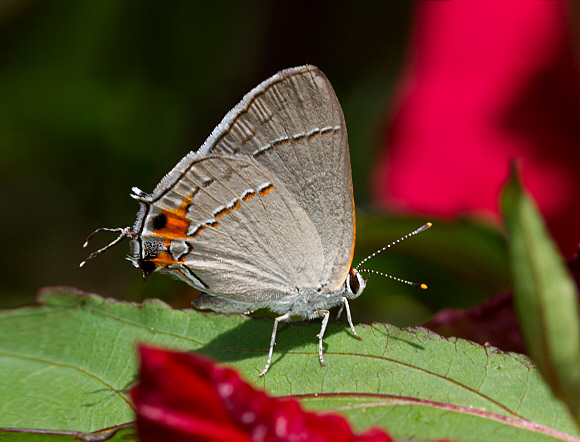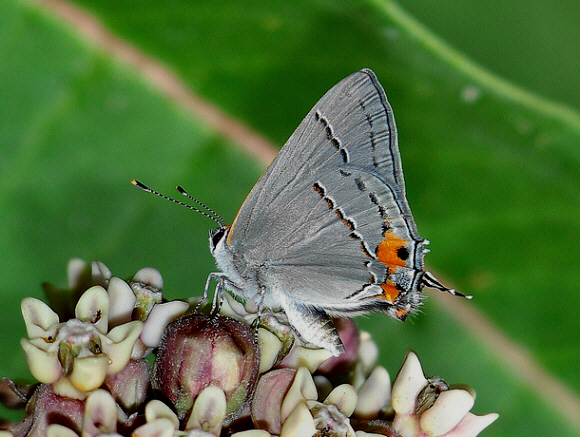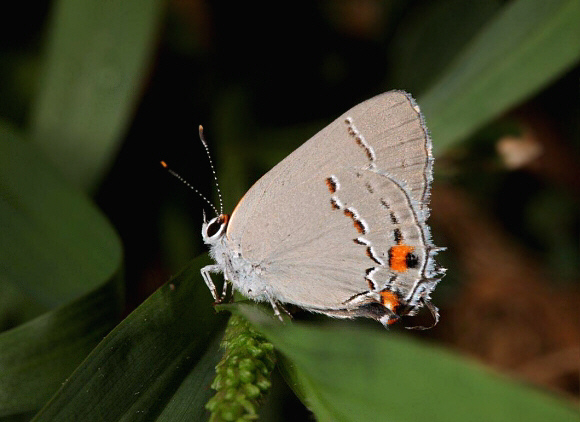
Introduction
Almost all neotropical and North American Theclinae species are placed in the Eumaeini. The tribe is not especially well represented in collections, so for a long time many remained unstudied and were inappropriately filed away in the ‘convenience’ genus Thecla. Many taxonomists have attempted to rationalise the systematics of the Eumaeini, the most recent being Robbins who published a revision in 2004, reclassifying the taxa into 83 genera. Currently there are 1058 known species. Taking into account their small size, secretive behaviour, and the great similarities between many species, it is estimated that about another 200 species probably remain to be discovered.
The genus Strymon comprises of 54 known species, variously distributed across the Americas from Canada to Chile and Uruguay. About 20 of these occur in North America.
The males of most species have metallic blue patches on the upper hindwings, sometimes also on the forewings. Females of all species have plain earthy brown uppersides. All species have a pair of short ‘tails’ at the tornus of the hindwing, although these are often lost after the butterflies have flown for a couple of days. The undersides vary considerably – e.g. in the davara group of species they are marbled in shades of brown; the acis group have pale brown undersides with prominent white hairstreak lines and a large orange patch near the tornus, and the basilides group have pale undersides with a broken band of reddish spots.
Strymon melinus belongs to the acis group. On the upperside both sexes are dark earthy brown with a slight bluish or greenish sheen, and have a conspicuous orange spot at the tornus. Males have a large dark squarish patch of androconial scales at the end of the fw discal cell.
The ventral ground colour varies from silvery-grey to pale reddish-brown according to subspecies. The white-edged black ‘hairstreak’ line is segmented in all subspecies except clarionensis, in which the line is contiguous, and edged inwardly with a broad red band. The latter subspecies is currently under review and is likely to be elevated to full specific status. In addition to clarionensis there are 7 other subspecies – setonia and atrofasciata from Canada; melinus, humuli and franki from the USA; pudica which occurs from Oregon and California to Nicaragua; and caldasensis which is known only from Colombia. It’s disjunct distribution suggests that caldasensis may in time be revealed to be another full species.
Strymon melinus is distributed from Canada to Colombia.

Habitats
This species is found in open flowery habitats at elevations between sea-level and about 600m.
Lifecycle
The egg is white and dome-shaped. In Mexico and the USA it is laid singly on the flowers or stems of the larval foodplants which include Eriogonum ( Polygonaceae ), Echinacea ( Asteraceae ) and Acacia, Olneya and Eysenhardtia ( Fabaceae ). The larva feeds on the flowerbuds, petals and seeds of the plants. It is louse-shaped, with bristly lappets below the spiracles. It exists in several colour morphs – pale green yellowish-green or purplish, matching the colour of the flowers or leaves of the various foodplants. In all varieties there are suffused forward-slanting diagonal white bars on each segment. Pupation takes place on the ground, and the pupa is quickly covered in debris by ants.
Adult behaviour
The butterflies are usually encountered in open sunny situations, perching on the foliage of bushes, or nectaring at Lantana, Senecio, Rubus, Eupatorium, Eriogonum and the flowers of numerous other bushes and herbaceous plants.

